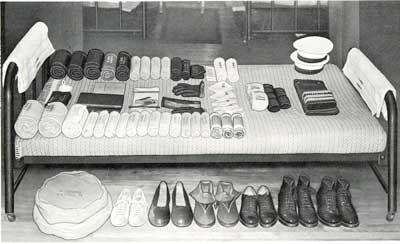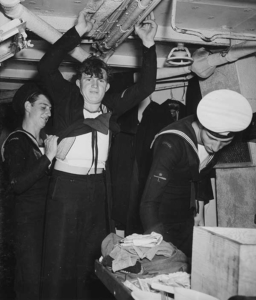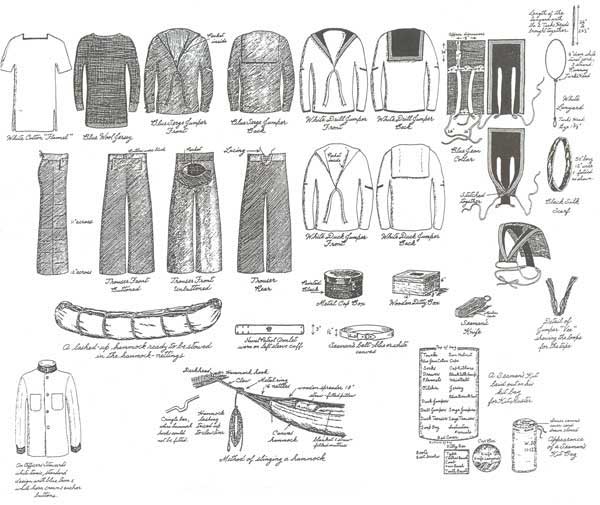
Kit layout had to conform to a precise pattern, with a location for each item. To deviate from this pattern was to invite reprimand or reproof.
Kit layout had to conform to a precise pattern, with a location for each item. To deviate from this pattern was to invite reprimand or reproof.One of the many practices the Royal Canadian Navy (RCN) inherited from the Royal Navy (RN) from its inception in 1910 was the requirement that when ordered to do so, a sailor had to produce all of his issue kit for inspection by a senior non-commissioned officer.
This practice was known as a kit muster, and it began during New Entry (basic) training. It would follow the sailor after he joined the fleet and throughout his career until he reached the rank of Petty Officer (PO). In the early days when sailors slept in hammocks, this kit had to be displayed on the cleanest of his hammock canvases which was laid out on the deck – in later years on his bunk – and it had to conform to a precise pattern, with a location for each item: boots, blankets, hammock clews (ropes attachments for lashing it to the ship’s hammock bars), caps, uniforms, sewing kit, lanyards, silks, slicker (rain gear), towels, blue jean collars, wool jerseys, underwear, white singlets with blue piping, etc.

Illustration of the proper method for embroidering personal kit items, from the RCN Seaman’s Handbook for 1962. Heaven help the hapless sailor who had an extremely long last name – the more letters, the more work.
Every item of clothing had to bear his initial, surname and service number, while his shoe brush, seaman’s dirk (knife) and the inside heels of his boots, and later shoes, had to display his service number pounded in with metal numbers and letters. Each issue item had to be accounted for, be clean and be in a state of good repair.

A sailor in his uniform, circa 1920s. The bell-bottomed trousers were designed so that they would roll up easily when scrubbing the decks. Note the characteristic seven horizontal creases, which some say represented the seven seas or five oceans. Photo Catalogue Number VR1999.758.32 from the museum’s collection.
Unauthorized changes to the issue items was not acceptable. Any missing, altered or worn out items had to be replaced out of the sailor’s monthly kit allowance. They could only come from the navy’s clothing stores, and had to be shown to the Navy’s police, the Regulating Petty Officers (RPOs, also known as “Crushers”), for their final approval, and recorded on his documents as having a complete and presentable kit. Failure to bring his kit up to standard could result in some form of punishment. Regulating Petty Officers were normally carried afloat only in cruisers or in later years aircraft carriers, but all major shore establishments had them, and they served under a Chief Petty Officer Regulator, The Master at Arms, known also as “The Master” or “The Jaunty”.
In the years prior to the outbreak of the Second World War all Boys, Ordinary Seamen, Able Seamen and Leading Seamen had kit musters twice a year, and afloat in destroyers and minesweepers this task fell to the senior Seaman branch non-commissioned officer, the Coxswain (Cox’n). Ashore the men carried their full kitbags to some building where it was inspected by the RPOs. Due to the wartime pressures of building a navy and training men, this practice was largely abandoned after New Entry training. Men under punishment for minor offences, or men held in cells for more serious ones, still had to muster their kits when ordered to do so.
In barracks or afloat, cases of theft might prompt the Commanding Officer (CO) or his second in command, the Executive Officer (XO), to have all the junior hands in the ship muster their kit in an attempt to locate the item or items alleged to have been stolen. In particular the Hostilities Only (HO) men of the Royal Canadian Naval Volunteer Reserve (RCNVR), who served only for the duration of the Second World War, found kit musters an annoying waste of time and said so, and in the smaller warships – fairmiles, corvettes and frigates – the COs wisely did not call for any kit musters.
In the RCN, the term “pusser” was used to describe anything that was government-issue, or a place where things were “done by the book,” and kit musters fell into this category. After the Second World War, some of the Permanent Force members of the RCN made an attempt to return the running of the RCN to the pre-war pattern, which meant a return to a more rigid, RN-style way of doing things. Regular kit musters were to be part of this.
Officially this meant that Leading Seamen were to muster their kits with other junior ranks, but unofficially they did not and were not normally required to do so. An official mandatory kit muster was expected before each draft, but unofficially, by the early fifties, few sailors ever had them. If they did, they took place at the major shore establishments, and not when in receipt of a ship-to-ship draft. Ashore they were expected to take their kit bags to the drill shed and lay their gear out there. However, two groups continued to be subjected to the practice due to their status: New Entries and men under punishment, though most often men in cells rather than those facing minor forms of punishment. Men in cells had no choice but to comply, and at HMCS CORNWALLIS, once again the central training establishment after mid-1949, kit musters became highly elaborate and ritualized affairs in which the appearance of the kit was paramount.

Sailors dressing for shore leave, 1945. Photo Catalogue Number VRP1995.30.166 from the musuem collection.
In 1960, the RCN published the Seaman’s Handbook which was issued to every non-commissioned member in the service. One chapter was devoted to the kit muster, and it explained in detail the why and the how of the practice, and the way in which a kit should be maintained, though not the frequency of the muster.
That slip-up was remedied in the 1962 edition, which stated that they were to be carried at every draft, “and probably once every six months or year that you are in any particular ship. Leading seamen and below are required to have kit musters.” Furthermore, “A petty officer second class may be ordered by the Captain to muster his kit.” There is nothing to indicate that kit musters along these lines were carried out after a man left CORNWALLIS; on the whole the regulations appear to have been ignored by COs and Cox’ns.
In addition, Volume I of the Manual of Rank Requirements (1961) for those at the Leading Seaman and Petty Officer 2nd Class level seeking promotion to the next highest rank explained how and why a kit muster was to be carried out, and then stated: “A kit muster is not a form of punishment. Resist the temptation to use it as such.” Temptation sometimes triumphed in the years before 1968 when all three armed services were unified under the title “Canadian Armed Forces.”

 CFB Esquimalt Naval and Military Museum
CFB Esquimalt Naval and Military Museum CFB Esquimalt Naval and Military Museum
CFB Esquimalt Naval and Military Museum CFB Esquimalt Naval and Military Museum
CFB Esquimalt Naval and Military Museum CFB Esquimalt Naval and Military Museum
CFB Esquimalt Naval and Military Museum CFB Esquimalt Naval and Military Museum
CFB Esquimalt Naval and Military Museum CFB Esquimalt Naval and Military Museum
CFB Esquimalt Naval and Military Museum CFB Esquimalt Naval and Military Museum
CFB Esquimalt Naval and Military Museum CFB Esquimalt Naval and Military Museum
CFB Esquimalt Naval and Military Museum CFB Esquimalt Naval and Military Museum
CFB Esquimalt Naval and Military Museum CFB Esquimalt Naval and Military Museum
CFB Esquimalt Naval and Military Museum CFB Esquimalt Naval and Military Museum
CFB Esquimalt Naval and Military Museum CFB Esquimalt Naval and Military Museum
CFB Esquimalt Naval and Military Museum CFB Esquimalt Naval and Military Museum
CFB Esquimalt Naval and Military Museum CFB Esquimalt Naval and Military Museum
CFB Esquimalt Naval and Military Museum CFB Esquimalt Naval and Military Museum
CFB Esquimalt Naval and Military Museum CFB Esquimalt Naval and Military Museum
CFB Esquimalt Naval and Military Museum CFB Esquimalt Naval and Military Museum
CFB Esquimalt Naval and Military Museum